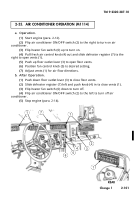TM-9-2320-387-10 - Page 153 of 277
TM 9-2320-387-10
2-105
2-40. OPERATING ON UNUSUAL TERRAIN
a. General Rules.
Driving off-road over rough or unusual terrain basically
requires using good driving sense. Experience is the best teacher, but there are a
few good rules to keep in mind when you are in that kind of driving situation.
.
WARNING
.
• Use extreme caution when transporting personnel. Rollover protection
is available for the crew area only and is not provided in the troop/
cargo area. Although certain design characteristics of the vehicle, such
as vehicle width, ground clearance, independent suspension, etc.,
provide improved capabilities, accidents can still happen.
• Operators are reminded to observe basic safe driving techniques/
skills when operating the vehicle, especially when transporting
personnel. Vehicle speed must be reduced consistent with weather
and road/terrain conditions. Obstacles such as stumps and boulders
must be avoided. Failure to use basic safe driving techniques/skills
may result in injury or death to personnel and damage to equipment.
(1)
Use H/L (high/lock range) or L (low range) only when absolutely required
by the conditions identified in table 1-7. After operations on unusual terrain, be
sure to shift the transfer case from H/L (high/lock range) or L (low range) to H (high
range) to avoid damaging drivetrain components.
(2)
Select proper transmission and transfer case driving ranges. Refer to table
1-6 for transmission range selections. For transfer case range selections, refer to
table 1-7.
(3)
Keep engine at a moderate speed. The engine works at its best pace in
mid-range revolutions per minute (rpm). You can slow down or speed up quickly
without changing gears if you get into a tight spot. Use transmission shift lever and
transfer case shift lever to control engine speed.
(4)
Attempt to keep wheels from spinning. If wheels start to spin, ease off the
accelerator pedal until wheels regain traction.
(5)
Instructions for placing vehicle in motion (para. 2-13) also apply to
operating on unusual terrain.
CAUTION
• When necessary to temporarily operate transfer case in H/L
(high/lock range) or L (low range) when additional traction is
needed to prevent wheel slippage, avoid sharp, continuous turns.
Failure to avoid sharp, continuous turns while operating transfer
case in locked ranges may cause damage to drivetrain.
• Immediately after operation in H/L (high/lock range) or L (low
range), ensure transfer case is shifted to H (high range) to avoid
damage to drivetrain. If any noises from drivetrain components are
heard, ensure that transfer case range is properly selected.
For proper transfer case range selection, refer to table 1-7. If transfer case range
selection is peculiar to an unusual operating condition, it will be specified in the
applicable paragraph.
Back to Top




















